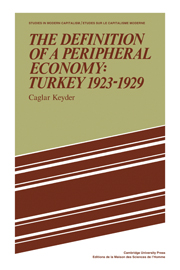4 - Trade relations with the world economy
Published online by Cambridge University Press: 06 July 2010
Summary
This study attempts to describe the structure of a peripheral formation and to trace the relationships with the world economy which shape it. It is, of course, principally through trade relations that a formerly external area becomes a periphery of the world economy. While this incorporation is brought about, merchant capital constitutes the main mechanism of peripheral structuration – the process whereby the economy in question is shaped to accommodate the hierarchical division of labour in the world economy. Such an accommodation does not consist merely of a market integration: it is also necessary that merchant capital transform certain existing products into commodities, and actively induce the production of new commodities. Thus, in the economic transformation of the periphery, trade relationship constitutes the impact that provides the important momentum. In the following we shall describe the overall importance of trade, its organisation, and the composition of merchant capital. The actual relations with (peasant) producers will be more extensively dealt with in the following chapter.
Importance of trade in the national economy
Between 1924 and 1928, average annual exports accounted for 11% of the national product. Imports, on the other hand, reached 23% of the GDP in the latter half of the decade. Although these figures do not provide overwhelming evidence that trade relations were the principal factor shaping the economy, we shall argue that they constituted the main dynamic in the development of commodity production. In the case of exports, the 11 % represented a commodity composition which was nine tenths agriculture based, and accounted for more than one half of non-grain production.
- Type
- Chapter
- Information
- The Definition of a Peripheral Economy: Turkey 1923–1929 , pp. 68 - 96Publisher: Cambridge University PressPrint publication year: 1981



